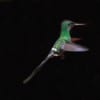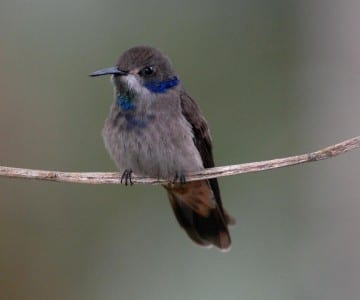 by Jim Stevenson
by Jim Stevenson
Howdy, I am back in civilization again and wanted to share some critters from Costa Rica which enjoy sugar through nectar. There are mostly hummers in the article but I have also included a couple of songbirds. My ten days making arrangements for the Venezuelan Tour has been made better by traveling with Bruce Anderson, the co-author (with my late father) of Birdlife of Florida. Bruce is an absolutely astute ornithologist and certainly keeps me on the avian straight and narrow. Perhaps more straight than narrow.

Black-bellied Hummingbirds are one of the few birds darker underneath than on top. Some others are species of plovers and sandpipers in breeding plumage.

Ever seen a hummingbird’s tongue? Do you know how long it takes to hit the shutter at the exact moment? 😉

There are several violetears, with this being the Brown Violetear. All of this group will sit high in trees making a chipping sound for 20-30 minutes at a time.

The Green Thorntail is a hummer of high elevations and fairly common in Costa Rican mountains. The bill is short but the tail makes up for it.

This female Green Thorntail is about the same color as the male but has a shorter tail. Note the white rump bar. This one is coming in for a landing.


The male Green-crowned Brilliant is a long hummer with a relatively short bill. Their camouflage is amazing when perched in leaves, like some other tropical species.

Female Green-crowned Brilliants are at least as green and this also helps when incubating on the nest. Note the post occular white spot.

Many hummers are quite green on the back to help even more with cryptic coloration, blending with leaves. This is the same as the last bird. Don’t ya dig the blue tail?

Bright colors in the wings and tail serve both as courtship, intimidation and attracting predators tvo an expendable portion of the body.

Mangos are hummers with a medial stripe running down the venter. This Green-breasted Mango’s stripe runs from thethroatto the belly, accentuating the bird’s bilateral symmetry.

Hummers like this mango have amazing abilities to stop, turn and reverse in mid-air. This group is now turning up in the southern US and as the earth continues to warm, they will bring their friends.

Most vertebrates have bilateral symmetry, where they are essentially the same on the left and right side. Congress doesn’t have this. But seriously, can you name any vertebrates that do NOT have bilateral symmetry? see answers below...


The Violet Sabre wing is one of our largest hummers and is about as violet as it gets. Many hummers have decurved bills but many do not. This often depends on their food source.

Hermits are drab-colored hummers with decurved bills and abiding natures. This is the Long-tailed Hermit feeding in a Heliconia, perhaps their favorite flower.

Honeycreepers are small, very colorful songbirds with a real taste for sweets. They should not be confused with the bewildering family of honeyeaters in Australia. This is the Purple Honeycreeper, with the yellow legs.

Honeycreepers are small, very colorful songbirds with a real taste for sweets. They should not be confused with the bewildering family of honeyeaters in Australia. This is the Purple Honeycreeper, with the yellow legs.

This immature male Red-legged Honeycreeper is in a transitional plumage, losing the green and gaining the purple. I think he looks a bit henpecked. Ok, vertebrates with no bilateral symmetry? I can only imagine some of you have been floundering for a response, so the sole answer is the tonguefish. I just asked that for the halibut. Now THOSE are flat funny, but don’t get depressed over it. Six trips in a row down, one more to go!

 Posted in
Posted in 
























